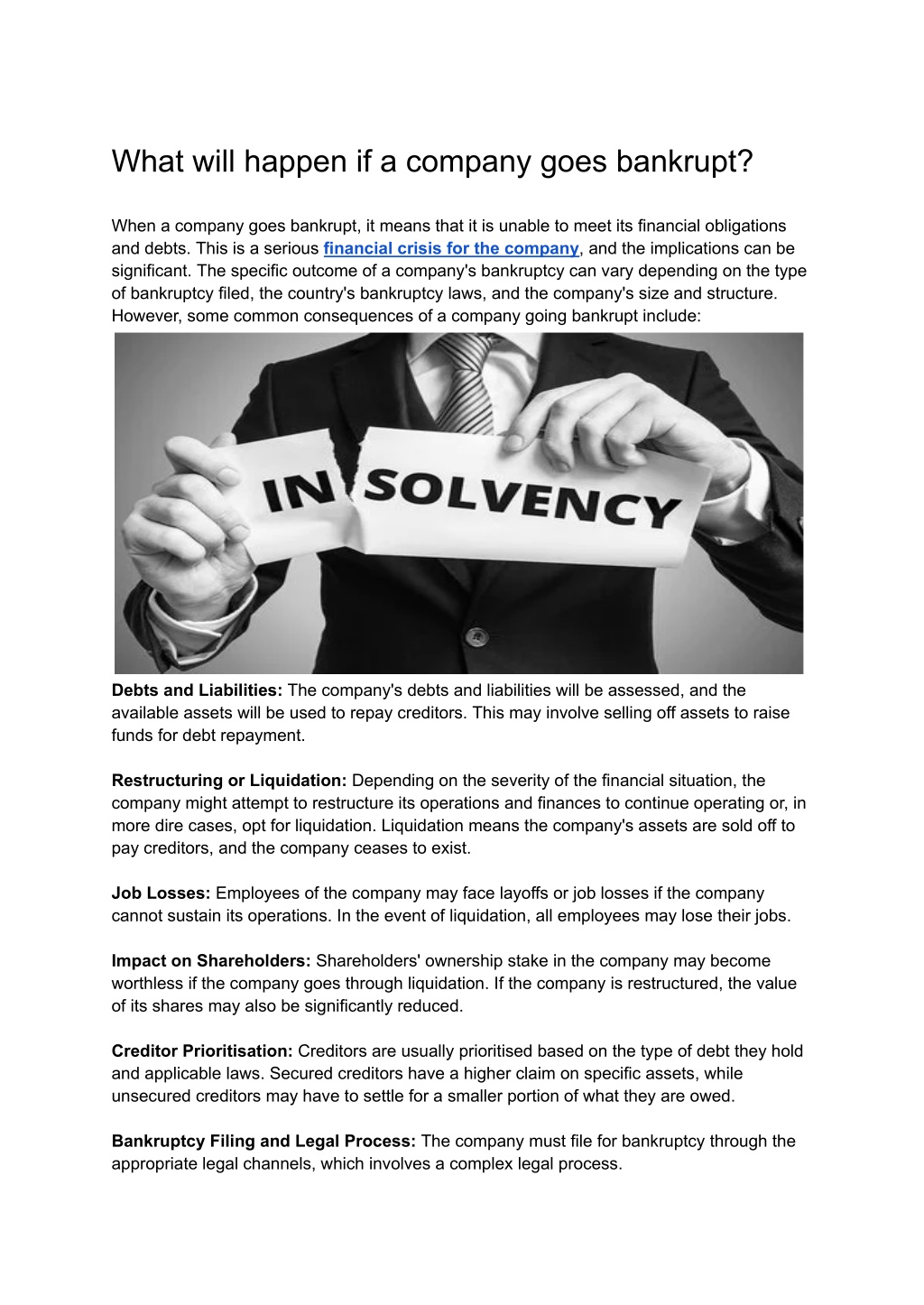Company Administration Explained: What Happens When Organizations Go into Liquidation?
Company Administration Explained: What Happens When Organizations Go into Liquidation?
Blog Article
The Process and Effects of a Company Getting Into Management
As a company faces monetary distress, the decision to go into management marks an essential juncture that can have far-reaching implications for all included celebrations. The procedure of getting in management is detailed, entailing a collection of actions that intend to browse the business in the direction of prospective healing or, in some instances, liquidation. Recognizing the duties and duties of a manager, the influence on different stakeholders, and the legal responsibilities that enter into play is vital in comprehending the gravity of this situation. The consequences of such a move ripple past the firm itself, shaping its future trajectory and influencing the broader business landscape.

Review of Company Management Process
In the realm of company restructuring, a vital first step is obtaining an extensive understanding of the detailed company administration procedure. Company administration describes the formal insolvency treatment that intends to rescue an economically troubled company or accomplish a far better outcome for the company's lenders than would certainly be possible in a liquidation scenario. This procedure entails the appointment of an administrator, who takes control of the firm from its supervisors to assess the monetary scenario and establish the most effective program of activity.
During management, the firm is provided security from legal action by its lenders, giving a halt period to formulate a restructuring plan. The administrator collaborates with the business's administration, lenders, and various other stakeholders to design an approach that might involve selling the business as a going issue, reaching a company voluntary arrangement (CVA) with creditors, or ultimately placing the company into liquidation if rescue efforts confirm futile. The key objective of firm administration is to optimize the return to creditors while either returning the company to solvency or shutting it down in an organized fashion.
Duties and Obligations of Administrator
Playing an essential duty in looking after the business's financial events and decision-making processes, the administrator assumes significant responsibilities throughout the business restructuring process. The primary duty of the manager is to act in the most effective rate of interests of the company's financial institutions, intending to accomplish the most desirable result possible. what happens to employees when a company goes into liquidation. This includes conducting a detailed evaluation of the company's economic circumstance, developing a restructuring strategy, and executing strategies to make best use of returns to creditors
Furthermore, the administrator is accountable for liaising with numerous stakeholders, including staff members, providers, and governing bodies, to guarantee openness and compliance throughout the management process. They need to additionally interact effectively with investors, providing routine updates on the firm's development and seeking their input when essential.
Furthermore, the manager plays an essential function in taking care of the day-to-day procedures of business, making essential choices to keep continuity and protect worth. This includes assessing the feasibility of various restructuring options, discussing with financial institutions, and ultimately directing the business in the direction of an effective exit from administration.
Effect On Firm Stakeholders
Presuming an important placement in looking after the firm's economic events and decision-making procedures, the administrator's actions during the corporate restructuring procedure have a straight influence on different business stakeholders. Shareholders may experience a decline in the worth of their financial investments as the firm's monetary problems are dealt with. Creditors, including distributors and lending institutions, may face uncertainties pertaining to the settlement of debts owed to them. Workers typically experience job instabilities because of potential discharges or modifications in work problems as component of the restructuring efforts. Consumers might experience disruptions in solutions or product availability throughout the administration procedure, impacting their count on and commitment towards the company. In addition, the community where the firm operates can be affected by possible job losses or modifications in the business's procedures, affecting neighborhood economic situations. Reliable communication from the administrator to stakeholders is essential in managing expectations, mitigating problems, and promoting openness throughout the administration procedure.
Lawful Implications and Responsibilities
Throughout the procedure of firm administration, careful consideration of the legal ramifications and commitments is extremely important to ensure compliance and safeguard the rate of interests of all stakeholders entailed. When a firm gets in management, it causes a collection of lawful needs that must be complied with. One of the primary obligations is for the appointed administrator to act in the very best interests of the company's creditors. This duty requires the administrator to conduct thorough investigations right into the firm's events, examine its monetary setting, and establish a technique to take full advantage of returns to creditors.
In addition, legal implications emerge concerning the treatment of staff members. The administrator must adhere to employment regulations relating to redundancies, worker civil liberties, and responsibilities to offer essential info to employee reps. into administration. Failure to follow these legal requirements can result in lawful action versus the company or its administrators
Furthermore, the company going into administration may have contractual responsibilities with numerous events, consisting of landlords, suppliers, and consumers. In essence, understanding and fulfilling legal commitments are critical facets of browsing a company through the administration procedure.
Methods for Business Recovery or Liquidation
In taking into consideration the future instructions of a business these details in administration, critical preparation for either recovery or liquidation is important to chart a viable course ahead. When intending for firm healing, key approaches might include performing a detailed analysis of the business procedures to determine inadequacies, renegotiating leases or contracts to enhance capital, and executing cost-cutting actions to improve profitability. In addition, seeking brand-new investment or funding options, branching out revenue streams, and concentrating on core competencies can all add to an effective recovery strategy.
Conversely, in situations where company liquidation is considered one of the most suitable strategy, methods would certainly involve check my reference maximizing the value of properties through effective possession sales, settling arrearages in a structured way, and following lawful requirements to make sure a smooth winding-up procedure. Interaction with stakeholders, including employees, clients, and lenders, is essential in either situation to preserve openness and handle assumptions throughout the recuperation or liquidation procedure. Inevitably, picking the right strategy depends on an extensive evaluation of the business's monetary health and wellness, market setting, and long-lasting potential customers.
Final Thought
To conclude, the process of a business entering administration involves the appointment of a manager, that handles the responsibilities of managing the company's events. This procedure can have considerable repercussions for various stakeholders, including shareholders, creditors, and staff members. It is necessary for business to carefully consider their alternatives and methods for either recovering from economic problems or waging liquidation in order to minimize prospective legal effects and responsibilities.
Company management refers to the formal bankruptcy procedure that intends to rescue a monetarily distressed company or accomplish a better outcome for the company's financial institutions than would be feasible in a liquidation scenario. The manager works with the business's management, lenders, and other stakeholders to create a strategy that might involve offering the organization as a going worry, getting to a business volunteer arrangement (CVA) with lenders, or inevitably putting the firm into liquidation if rescue attempts confirm futile. The main objective of company administration is you could try here to maximize the return to lenders while either returning the firm to solvency or closing it down in an orderly way.

Report this page